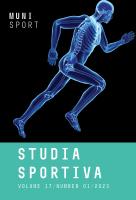Socio-Culturally Different Motor Skills of Czech Children with ASD Aged 7-10 Years Assessed by the Test TGMD–3
Socio-Culturally Different Motor Skills of Czech Children with ASD Aged 7-10 Years Assessed by the Test TGMD–3
Author(s): Tereza Možná, Hana Válková, Hana PodhornáSubject(s): Social Sciences, Sociology, Health and medicine and law, Sports Studies
Published by: Masarykova univerzita nakladatelství
Keywords: autism; spectrum disorders; ASD; motor; test; TGMD-3; TGMD; socio-culturally different skills
Summary/Abstract: Background: Autism spectrum disorders (ASD) are associated with gross motor development delays and a limited ability to imitate human movements. Early intervention in the field of motor skills is crucial both from the point of view of the need for comprehensive care for these children and to increase their quality of life. Diagnostic evaluation tools for use in practice are a necessary prerequisite for targeted intervention programs. The Test of Gross Motor Development–Third Edition (TGMD-3) is declared for use in children with ASD (Ulrich, 2019). The TGMD-3 was developed in the USA and consists of two subtests – Locomotor and Ball skills. The Ball skills subtest contains culturally different elements such as strike stationary ball and underhand throw, performed according to US practice. For these reasons, modifications have been made in some countries in the European socio-cultural environment (Wagner et al., 2017) that do not include these elements typical of the US environment. The aim of this study was 1) to record and describe the reactions of children with ASD to culturally different elements in the ball skills subtest in the TGMD-3 motor test and 2) to compare their evaluation with other items of this subtest. Methods: This pilot study included 16 children with ASD aged 7-10 years. A total of 1 girl and 15 boys were evaluated by the TGMD-3 motor test using visual support. (Allen et al., 2017) Four independent examiners assessed participants' physical performance by following the instructions of the Examiner's Manual Test TGMD-3 3. Results: The results of the study are presented in the form of case studies of individual participants, which allow for further research in this heterogeneous population of children with ASD with better descriptive and comparative possibilities than statistical numerical expression. The limited ability to imitate, which is characteristic of children with ASD, is likely to have a significant effect on culturally dissimilar designs, especially the Underhand throw. The two-hand strike of a stationary ball's culturally different skill was very motivating for children with ASD aged 7-10. Conclusion: The limiting factor for generalization to the entire population of children with ASD aged 7-10 in the Czech socio-cultural environment is their small number and heterogeneity, which were affected by restrictive measures during the Covid-19 pandemic. Further research using the TGMD-3 instrument in the Czech population has the potential to expand diagnostic methods in the field of motor skills and contribute to the possibilities of early physical intervention in children with ASD.
Journal: Studia sportiva
- Issue Year: 17/2023
- Issue No: 1
- Page Range: 116-126
- Page Count: 11
- Language: English

